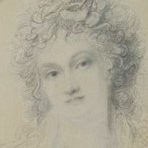Hélène de Montgeroult (1764-1836)

Who is Hélène de Montgeroult?
Born in Lyon in 1764, Hélène de Montgeroult was highly praised by her contemporaries as a pianofortist, composer and teacher.
The pianist
"The whole direction of Madame de Montgeroult's talent was towards expression and the art of singing."
Baron Louis de Trémont (1779-1852)
All those who had the privilege of hearing her were unanimous: Hélène de Montgeroult was an immense pianist, a brilliant improviser and virtuoso. Her touch and the expression of her playing were particularly aknowledged. Hélène de Montgeroult's social status as a marquise did not allow her to perform in concert halls. She also always preferred to play for a select audience of true music lovers rather than in salons where cards were played and people chatted during the performance of musical 'entertainments'. This is why, as soon as she started composing, Hélène de Montgeroult only played at home.
The composer
" There is Schubert, Impromptu-style, in Etude No. 62; Chopin, Op. 10 No. 12, in Etude No. 107; and even Brahms, Intermezzi-style, in Etude No. 104."
Jérôme Bastianelli, Critique des Études d’Hélène de Montgeroult, Diapason, 2007
Hélène de Montgeroult's work includes Sonatas, Fantasias, Nocturnes and above all a "Complete Course for the Teaching of the forte piano, leading progressively from the first elements to the greatest difficulties". In this course there are 972 exercises and 114 studies which are more akin to "musical moments" or "impromptus" than to the arid exercises which were common at the time.

The pedagogue
"If singing well is the greatest difficulty on all instruments, one might almost despair of overcoming it on the Forte-Piano, which, deprived of the faculty of sustaining sounds, has given everything when touched; but feeling makes one ingenious, and the need to express what one feels can create resources that escape the mechanic."
Hélène de Mongeroult , Observations sur l’Étude n°110.
Madame de Montgeroult was the first woman to teach at the Conservatoire National de Paris. She was hired as soon as it was created in 1795, as a "first class teacher, men". Three years later she resigned for health reasons. She taught the music of Johann Sebastian Bach and Handel to her students. Her course shows a great concern for pedagogy: she prefaces each piece with a few words to point out the pitfalls to be avoided and to suggest working methods.
Montgeroult's life
Hélène de Nervo
1764 Birth of Hélène de Nervo in Lyon
1766 Birth of his brother Christophe-Olympe in Paris where the family seems to have settled
1776 Lessons with Hüllmandel, an Alsatian musician who studied with Carl Philip Emmanuel Bach
1784 Marriage to André-Marie-Gautier marquis de Montgeroult
Marquise de Montgeroult
1785 « Premier concerto pour piano », adapted from a concerto by Viotti that she has just met
1786 Lessons with Dussek, who dedicated to him Three sonatas for Harpsichord or Forte-Piano, two of which with Violin obligé and the third without Accompaniment op.5
1788-1789 Begins to write her "Complete Course".
During the Revolution
1789 14 July, storming of the Bastille. First wave of emigration
1792 July to December: stay in England after the sale of the Château de Montgeroult
1793 A trip to Germany around Easter. Unexpectedly, she replaces her host, an organist suffering from an attack of gout, at the Easter service. The Montgeroult couple leaves for Naples with a secret diplomatic delegation. Arrest by the Austrians in Novale (Italy). The delegates are taken to Mantua and imprisoned. Hélène is released soon after but her husband remains in prison where he dies on 2 September. Search of the Montgeroult's home. Return to Paris in October
1794 Hélène de Montgeroult, incarcerated in the Conciergerie, saves her head, it is said, by playing and improvising brilliantly on the theme of the Marseillaise
Professor at the Conservatoire de Paris
1795 Professor "de première classe" at the newly created Conservatoire de Paris. In charge of the piano class Men. First and only female instrumental teacher at the Conservatoire at that time. Birth of her son Aimé-Charles-Horace. Publication of Trois sonates op.1
1796 Trip to Berlin to publish her Sonate en fa mineur
1797 Marriage to Charles-Antoine-Hyacinthe His who gave his name to Hélène's son. Aimé-Charles-Horace His de la Salle became an eminent art collector, particularly of drawings, which he bequeathed to the Louvre. Under the title « Officier et gentleman au XIXème siècle: la collection His de la Salle au musée du Louvre », an exhibition has been dedicated to his donation between the end of 2019 and February 2020 at the Louvre.
1798 Resignation from the Conservatoire (it was not until 50 years later and the appointment of Louise Farrenc that there was once again a woman piano teacher at the Paris Conservatoire)
Composer
1800 Trois sonates op.2. Cours de contrepoint avec Reicha
Sous le Premier Empire
1802 Divorce from Charles-Antoine His
1804 Pièces pour piano op.3
1804-1807 Trois Fantaisies op.4 et Trois sonates op.5
1807 Six Nocturnes op.6
1810 achèvement du Cours complet pour l’enseignement du Forté-Piano conduisant progressivement des premiers éléments aux plus grandes difficultés, en trois parties.
1812 the Complete course is still in print
During the Restoration
1818 Stays in England
1820 Edition of the Cours complet at Janet&Cotelle. Marriage to Count Dunod de Charnage
1826 Death of Count Dunod de Charnage
Italy
1834 departure for Italy with his son
1836 Died in Florence where she is buried (Santa Croce)
Jérôme Dorival, musician and historian, devoted a very detailed study to this artist, published in 2007 by Symétrie under the title "Hélène de Montgeroult, la Marquise et la Marseillaise".
